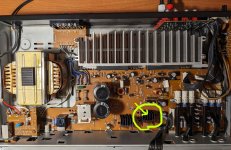Hi everybody.
I'm a newbie when it comes to amp circuits, but I wanted to troubleshoot an annoying 50hz hum coming out of the left channel of my old Akai AM-A302 amp (ground loop?).
I tried connecting the amp chassis to a radiator (ground) using a wire and the noise got worse, so I brainlessly started probing random points inside the amplifier using the same wire that was still connected to the radiator.
As soon as I touched a transistor heatsink (TR5 to be specific) I saw a blueish flash and the amplifier died instantly.
Then, after turning the amp on and off a few times, I inadvertently brushed my knuckle against the chassis and I received a nasty shock. I do not remember whether the amp was on or off when I got shocked.
Setting aside my colossal stupidity for a moment, I have a few questions I was hoping you could answer, so that I might learn something from this experience:
Thanks in advance.
I should preface this by saying that the thing I just did was very careless and stupid and I will never attempt something like that again.
I'm a newbie when it comes to amp circuits, but I wanted to troubleshoot an annoying 50hz hum coming out of the left channel of my old Akai AM-A302 amp (ground loop?).
I tried connecting the amp chassis to a radiator (ground) using a wire and the noise got worse, so I brainlessly started probing random points inside the amplifier using the same wire that was still connected to the radiator.
As soon as I touched a transistor heatsink (TR5 to be specific) I saw a blueish flash and the amplifier died instantly.
Then, after turning the amp on and off a few times, I inadvertently brushed my knuckle against the chassis and I received a nasty shock. I do not remember whether the amp was on or off when I got shocked.
Setting aside my colossal stupidity for a moment, I have a few questions I was hoping you could answer, so that I might learn something from this experience:
- How exactly did I kill the amp? What exactly was it that killed the amp? An excess of current somehow somewhere?
- What component(s) or part of the circuit did I kill? Is half the circuit dead or could I just replace a few components and be good to go?
- Why is the chassis now conducting electricity? Has the circuit changed, making the chassis a hot and active part of it?
- Is the amp salvageable?
Thanks in advance.
Attachments
1) likely shorting power supply to ground
2) regulator or else
3) even power supply can give you shock if its high enough
4) yes, but not by you
2) regulator or else
3) even power supply can give you shock if its high enough
4) yes, but not by you
4) - ROTFL. Or maybe 868 posts later.
My guess is a fusible resistor, perhaps with some collateral damage. Logically, that would be the negative regulator for the preamp section (green indicates PNP in those days) and just shorted the INPUT to it, discharging a big or big-ish cap which made the blue flame come out. That may or may not have fried the transistor too. Many times these regulators have fusible resistors in the collector, for just this type of event. Doesnt always save the regulator transistor, but usually saves everything hooked up to it.
My guess is a fusible resistor, perhaps with some collateral damage. Logically, that would be the negative regulator for the preamp section (green indicates PNP in those days) and just shorted the INPUT to it, discharging a big or big-ish cap which made the blue flame come out. That may or may not have fried the transistor too. Many times these regulators have fusible resistors in the collector, for just this type of event. Doesnt always save the regulator transistor, but usually saves everything hooked up to it.
At least you got to see the flash. For most of us, causing a flash puts us off for a couple of days. But not you....I saw a blueish flash

